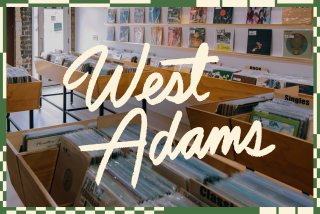History Is People, Not Bricks : Olvera Street: Mexicans were here long before the gringo. A multi-ethnic museum would trample that heritage.
- Share via
News that a small group of preservationists seeks to transform Olvera Street from a Mexican marketplace into a multi-ethnic museum should outrage Latinos. After all, the plaza area has been inhabited by Mexicans since 1781, when a dozen or so peasants, mostly from the Mexican states of Sinaloa and Sonora, founded the Pueblo of Los Angeles. Spending time on Olvera Street is thus a trip through tradition.
From 1900-1930, bulldozers virtually cleared the civic center of all else that was Mexican, mostly family homes. Then, Christine Sterling and members of the city’s social and economic elite moved, in the late ‘20s, to save and preserve Olvera as a symbol of Los Angeles’ Mexican heritage. The street was little more than an alley. Like the Avila adobe, which had been condemned, its days were numbered.
At first, Olvera was part of California’s “Fantasy Heritage”--a tourist trap. But over the years, its people reintegrated it with the plaza and Our Lady Queen of the Angels, the city’s oldest church. Mexicans and other Latinos began returning to Los Angeles’ Bethlehem. Today, Olvera Street is where many of us go to celebrate our holidays or to enjoy the oldest remnant of the Mexican heritage in the center of the city.
Certainly, a tradition worth preserving. Right?
Jeane Poole, curator of El Pueblo Historic Park, has embraced Olvera Street’s dilapidated buildings--mostly stucco and red brick--rather than its traditions and people. It’s no secret that she believes the Mexican presence on Olvera Street so overwhelming that the contributions of the Chinese, the Italians and other neighborhood ethnic groups to the city’s development have been eclipsed. To dilute the Mexican presence, she has advocated that restoration of Olvera Street spotlight the architecture of its buildings. Toward this end, she has enlisted the support of architectural historians.
For 12 years, Poole and her gaggle of Anglo historians have been plotting to impose their Mexican-less vision of Olvera Street. Their opportunity for success came when administration of El Pueblo Park passed from state to the city Recreation and Parks Commission. Eager to renovate, the commissioners put together a proposal. Since they and the Recreation and Parks Dept. lack the expertise to make historical recommendations, Peter Snell, an architectural historian, was paid to make some. Snell is a close friend of Poole and has acted as a consultant for El Pueblo Park.
The commission’s proposal calls for Olvera Street to be renovated and its history interpreted in conformity with the architecture of the “Prime Historic Period” of 1920-1932. Why 1920-1932? Why not 1880-1910? For one thing, the latter would involve tearing down what constitutes today’s Chinatown to make way for reconstruction of Sonora Town.
In any case, historians will tell you that “Prime Historic Periods” are convenient covers for diluting the influence of unwanted groups. In the case of Olvera Street: No Mexicans Wanted.
What the commissioners and the building-oriented historians are forgetting is that, like it or not, if it had not been for the Mexican marketplace, there would be no preservation debate, since there would be no buildings to preserve. Before Mexican merchants moved in, many of Poole’s “Prime Historic” buildings were slated for demolition--the preferred people-remover technique in the ‘30s. But when the alley became a thriving marketplace, those dilapidated stucco and red-brick buildings that Poole now waxes poetic over were saved.
History is made by people, not by buildings. The Latino hegemony in the plaza area is a reminder that Mexicans, here long before the Gringo, are not aliens. Put a plaque on those buildings to indicate that they are proud examples of the Poole’s “Prime Historic Period.” As for Olvera Street, the plaza area and its people, they are too alive to be turned into a musty museum built by Poole and Associates.
More to Read
Sign up for Essential California
The most important California stories and recommendations in your inbox every morning.
You may occasionally receive promotional content from the Los Angeles Times.













